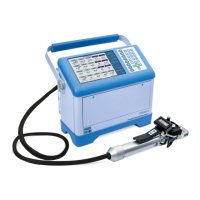CIRAS-3 Operation Manual V. 1.09 128 support@ppsystems.com
Photochemistry and heat dissipation effectively result in the quenching of fluorescence. The amount or
yield of fluorescence can tell us how efficiently PSII is operating.
How do we measure fluorescence? CFM-3 is a pulse modulated (PAM) fluorometer and the modulating
or measuring lights are used to produce a fluorescence signal without inducing photosynthesis (actinic
effect), which interferes with the fluorescence signal. Applying the modulating light intermittently at a
certain frequency, the detector can distinguish the intermittent measuring light from the background
actinic light. It outputs a signal equivalent to the proportion of light re-emitted as fluorescence.
measured, detector – Fluorescence signal (current)
o
measured, detector - minimum F yield, sample dark-adapted
m
measured, detector - maximum F yield, sample dark-adapted
v
calculated - variable F yield, sample dark-adapted
v
m
calculated - maximum photochemical efficiency of PSII, sample dark-adapted
m
measured, detector - maximum F yield, sample illuminated
s
measured, detector - steady-state F yield, sample illuminated
calculated - photochemical efficiency of PSII, sample illuminated
o
measured, detector - minimum F yield, sample illuminated by far-red light
o
calculated, minimum F yield, requires Fv/Fm
v
calculated – variable F yield, sample illuminated by far-red light, requires F
o
v
m
calculated - photochemical efficiency of PSII, sample illuminated by far-red light ,
requires F
o
Ꞌ
calculated - thylakoid electron transport rate (µmol e
-
m
-2
s
-1
)
calculated - photochemical quenching coefficient, correlates to proportion of open PSII
reaction centers in puddle antenna model, requires F
o
Ꞌ
calculated – non-photochemical quenching, older term, insensitive to higher quenching
values, requires F
o
Ꞌ
calculated - non-photochemical quenching, correlates to heat dissipation via xanthophyll
cycle and PsbS protein
calculated - photochemical quenching coefficient, correlates to proportion of open PSII
reaction centers in lake antenna mode, requires F
o
Ꞌ (Kramer calculation)

